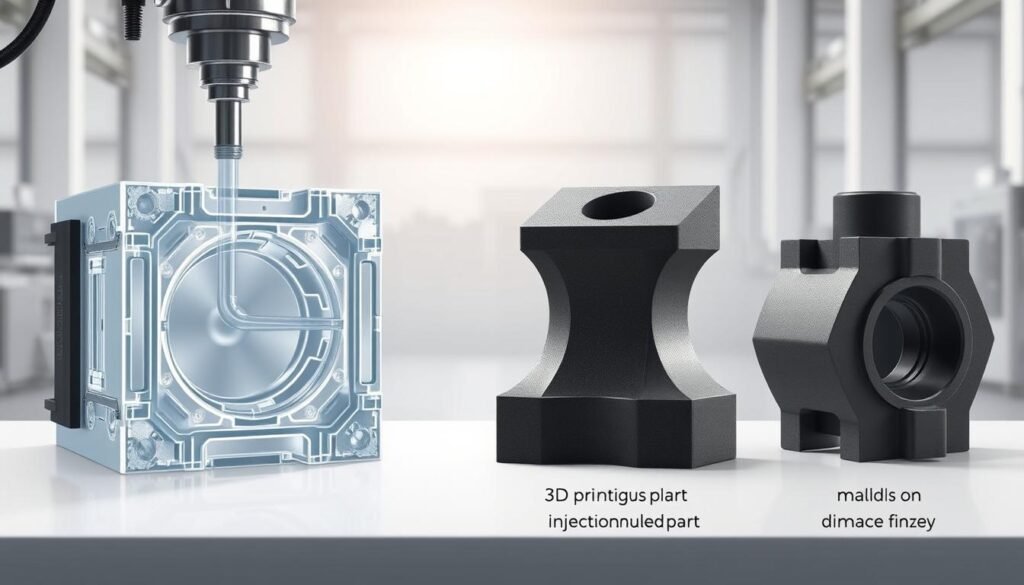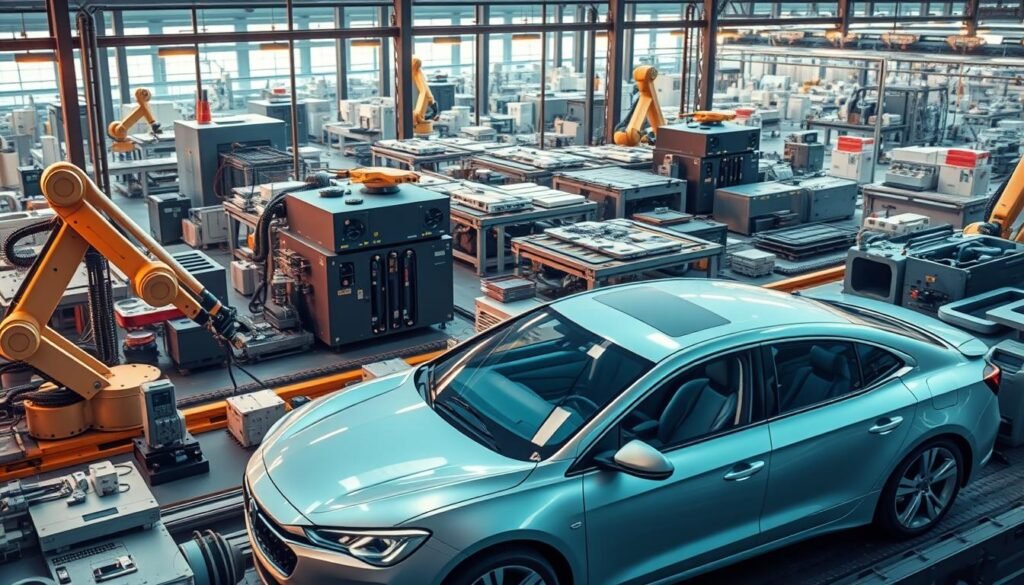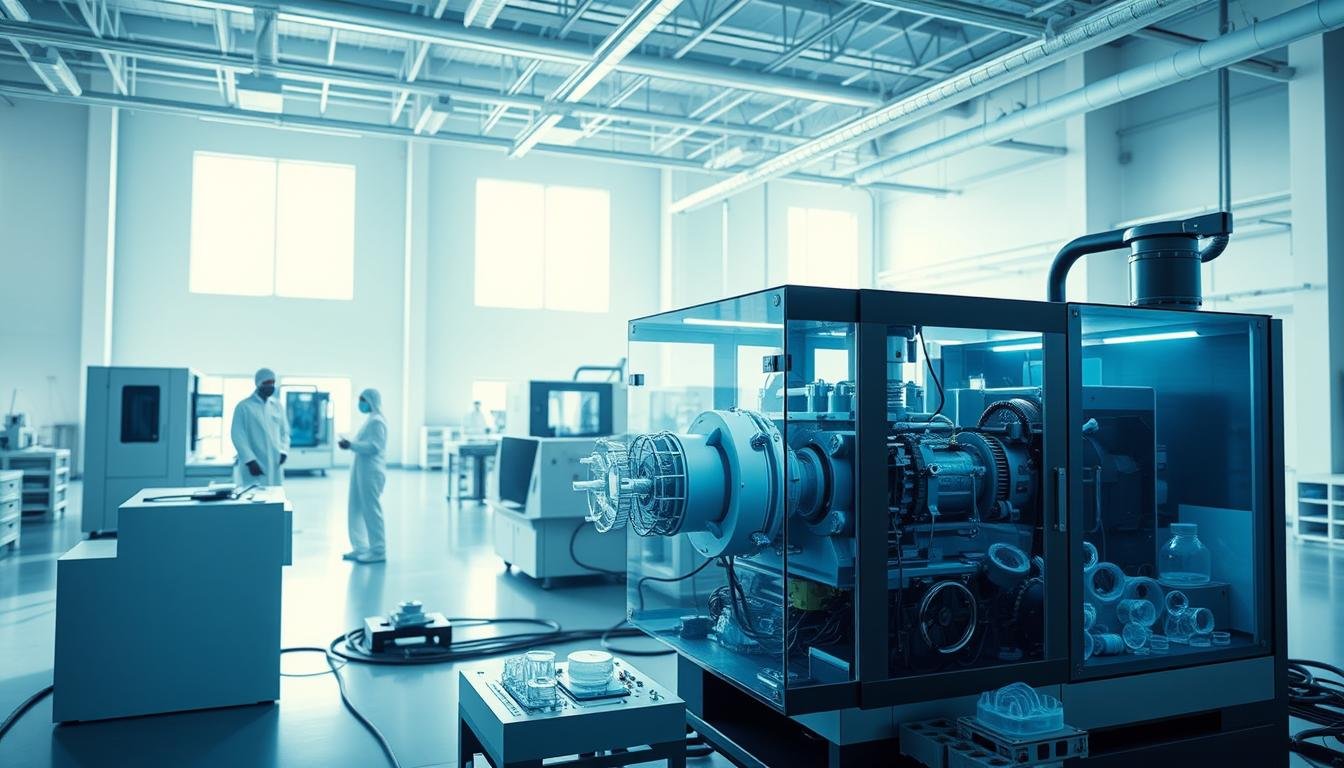Injection molding is a top choice for making plastic parts. It’s great for making lots of parts quickly and well. This method helps businesses meet growing needs for scalable production. It’s key to modern making processes.
We’ll look into how injection molding works, the materials used, and its cost savings. It makes making parts faster and better. Plus, it helps meet green goals, as shown in this piece on scalable plastic injection molding.
Key Takeaways
- Injection molding produces high-quality plastic parts efficiently.
- It supports scalable production, meeting industry demands.
- The process is cost-effective for high-volume manufacturing.
- Materials used enable design flexibility and complex geometries.
- Automation enhances speed and accuracy in production.
- Innovations are driving sustainability in injection molding.
Introduction to Injection Molding
Injection molding is a key method in manufacturing. It offers unmatched efficiency and precision. This method makes complex parts from different materials for many industries.
It’s used for making everything from everyday items to car parts and medical devices. Its ability to produce lots of parts quickly is crucial for businesses.
Knowing how injection molding works helps businesses improve their production. We’ll dive deeper into its benefits for efficiency and quality.
What is Injection Molding?
Injection molding is key in making plastic parts today. It turns raw materials into detailed products quickly. Knowing how it works helps businesses choose the right materials for their needs.
Overview of the Injection Molding Process
First, plastic pellets go into the machine’s hopper. These are usually thermoplastics like polyethylene, polypropylene, or ABS. They get heated in the barrel of the machine.
A screw mixes and melts the pellets well. This happens at temperatures from 150°C to 370°C. Getting the plastic just right is important.
Then, the plastic is pushed into a mold under high pressure. This pressure makes sure the plastic fills the mold fully. It also stops air pockets from forming.
After that, the plastic cools and hardens. The mold has cooling channels to help with this. This step is crucial for the product’s quality and shape.
When the plastic is hard, the mold opens. Ejector pins help take out the part. Then, sprues and runners are removed. This lets the part move on to more steps in production.
Materials Used in Injection Molding
Injection molding uses many thermoplastic materials. Each has special qualities for different uses. Some common ones are:
- Polyethylene (PE): It’s strong and flexible, good for many products.
- Polypropylene (PP): It’s great for containers and car parts because it resists chemicals well.
- Acrylonitrile Butadiene Styrene (ABS): It’s tough and often used in things people buy and appliances.
These materials make injection molding fast and flexible. They meet many needs in different industries.
The Efficiency of Injection Molding for High-Volume Production
High-volume injection molding is very efficient and productive. It’s a top choice for many manufacturers. Managing cycle times is key to its success.
Understanding Cycle Times and Throughput
Cycle times in injection molding can be short or long. They depend on part complexity and material. Short cycle times mean more parts made faster.
By balancing cycle times and machine power, companies can make more parts. This boosts their production efficiency.
Automation in Injection Molding
Automation in injection molding makes things run smoother. It handles tasks like feeding materials and checking quality. This cuts down on labor costs and errors.
With automation, production becomes more reliable and consistent. It helps meet high production targets easily.
Cost-Effectiveness and Scalability of Injection Molding

Injection molding is great for businesses wanting to save money and make more. The first cost is high because of mold making. But, as you make more, you save a lot more.
Economies of Scale When Increasing Production
When you make more, the mold cost spreads out. This makes each item cheaper. You can make lots without spending too much more.
Material Efficiency and Waste Reduction
Injection molding is also very good at using materials. It uses just the right amount, making less waste. You can even use leftover material again, saving money and the planet.
Design Flexibility with Injection Molding
Injection molding offers a big plus in making many kinds of products. It lets makers create complex shapes that fit exact needs. This means parts can look good and work well in tough situations.
Complex Geometries and Customization
Injection molding is great for making detailed designs. It’s not just for simple shapes. It lets makers create parts with special features and looks.
- Customization options include:
- Unique shapes tailored to specific applications
- Incorporation of features like ribs and bosses
- Integration of different materials for functionality
Getting parts to fit together right is key. Keeping tight tolerances makes sure each part works well. This is important for making high-quality products.
Consistency and Precision in Production
In the world of making things, injection molding precision is key. It makes sure every part is up to standard. To keep quality the same, we pick the right materials and use new ways to make things.
Car and medical industries need this to keep their products safe and working right.
Maintaining Quality Across Production Runs
To keep things consistent and precise, we use a few strategies:
- Regularly calibrate machines to keep production steady.
- Have strict quality checks at every step of making things.
- Use advanced software to watch and adjust things as they happen.
These steps help a lot in keeping the high standards needed for injection molding precision. By keeping quality up throughout making, we meet our customers’ needs better. We also cut down on waste and make things more efficient.
Reduced Lead Times in Injection Molding Production
In today’s fast world, making parts quickly is key. It helps companies keep up with changing market needs. Using new methods and tools, they can get products to market faster, staying ahead.
How Quick Setup Supports Fast Turnaround
Quick setup is crucial for avoiding delays. Injection molding uses aluminum molds for faster making. This can cut lead times to just one day for prototypes and final parts.
We focus on precision, with tolerances of +/- 0.003 inches. This ensures every piece is top-notch.
Our use of scientific molding cuts cycle times, making production more efficient. Plus, our Design for Manufacturability (DFM) feedback boosts production speed.
For industries needing new products fast, having over 100 thermoplastic materials is vital. This range meets different needs quickly. Injection molding’s flexibility also allows for many uses.
Comparing Injection Molding with Other Manufacturing Processes

Injection molding is a top choice when comparing it to other methods. It’s efficient and cost-effective, perfect for making lots of items. This makes it great for big orders, beating out additive manufacturing and traditional methods.
Injection Molding vs. Additive Manufacturing
Additive manufacturing is best for small projects and prototypes. It’s flexible and lets you create detailed designs without spending a lot upfront. But, injection molding is better for making lots of items because it’s cheaper per piece as you make more.
Injection molding is also faster and more consistent than additive manufacturing. This is key for making lots of items quickly and with the same quality.
Advantages Over Traditional Techniques
Traditional methods take a long time to set up and cost a lot at first. Injection molding is quicker and has lower start-up costs. It also makes items more precisely and consistently, which means fewer mistakes.
This leads to happier customers and lower costs for making lots of items. Injection molding is more reliable and efficient than traditional methods.
| Feature | Additive Manufacturing | Injection Molding | Traditional Manufacturing |
|---|---|---|---|
| Best Use Case | Prototyping, Low Volume | High Volume Production | Medium to High Volume |
| Cost Efficiency | Higher per-unit costs | Lower per-unit costs as volume increases | High initial costs with variable efficiency |
| Speed | Slower for large batches | Fast cycle times | Lengthy setup times |
| Design Flexibility | High | Moderate, but can accommodate complex shapes | Low, strict design limitations |
| Material Waste | Lower material waste | Efficient material usage | Higher material waste |
Technological Innovations in Injection Molding
New modern manufacturing technology has changed injection molding a lot. It now uses Industry 4.0 tech for better work and care for the planet. The Internet of Things (IoT) lets us watch production live and fix problems fast.
Artificial Intelligence (AI) helps a lot with checking quality. AI can spot problems before they happen. This keeps production top-notch and saves time and money.
These new techs make injection molding better for the environment and more efficient. As we keep using these techs, we’re moving toward a future where making things well also means being green.
Environmental Impact of Injection Molding

The environmental impact of injection molding is a big deal today. We need to know how it affects our planet. Making injection molding more sustainable is key.
This means using biodegradable materials and saving energy. These steps help reduce our carbon footprint.
Sustainability in Material Usage
Using materials wisely is crucial for sustainability in injection molding. Companies are working to cut down waste. This lets them recycle more plastic parts.
They use closed-loop systems to reuse leftover material. This greatly lowers environmental harm. It also helps in creating a circular economy.
Challenges and Considerations in Injection Molding
Injection molding has many benefits but also some challenges. Costs for starting and mold design complexity are key. Knowing these helps plan and execute projects better, leading to success.
Initial Setup Costs and Mold Design Complexity
Starting with injection molding means big upfront costs, mainly for mold design and making. These costs change based on:
- Materials used for the mold
- Complexity of the part design
- Size and type of the injection molding machine
- Number of cavities in the mold
How complex the mold design is affects the time and resources needed. More complex designs need better engineering and materials. This can raise costs. Businesses must think about these costs against the long-term benefits of injection molding.
Planning well and working with experienced designers can help. Using industry knowledge can make mold design better. This can lower setup costs and speed up production. Tackling mold design issues early makes manufacturing easier and ensures quality.
| Aspect | Description | Impact on Costs |
|---|---|---|
| Initial Setup Costs | Upfront investments for mold creation and equipment. | High due to material and labor costs. |
| Mold Design Complexity | Influences material selection and fabrication techniques. | Increases costs if high complexity is required. |
| Production Efficiency | Long-term reductions in cycles per part produced. | Justifies initial costs over time through scale economies. |
Industries Benefiting from Injection Molding

Injection molding is key in many industries. It’s a top choice for making important products. The car and health sectors use it a lot because it makes lots of quality parts fast.
Applications in Automotive and Healthcare
In cars, injection molding makes dashboards, panels, and parts. It ensures these parts are safe and work well. In healthcare, it helps make medical devices. This makes sure products are consistent and follow health rules.
Use in Consumer Products
Many consumer items also use injection molding. Things like kitchen stuff, toys, and electronic parts show its wide use. It makes durable, quality products quickly, helping businesses meet customer needs.
Conclusion
Injection molding is a key process for making products in large numbers. It makes parts of high quality, which is important today. It also lets companies make different designs and amounts of products.
This method is also good because it saves money. It uses new technologies and automation. This makes making products faster and better for the environment.
Using injection molding helps businesses meet customer needs and stay ahead. It’s a smart choice for companies wanting to grow and succeed. It helps them make more and better products.
FAQ
What is the injection molding process?
Injection molding melts material and injects it into a mold. It then cools and solidifies into the desired shape. The steps include melting, injecting, cooling, and ejecting the product.
What materials are commonly used in injection molding?
Thermoplastics like ABS, polypropylene, and nylon are common. Elastomers and reinforced plastics are also used for specific needs.
How does injection molding compare to other manufacturing processes?
Injection molding is great for making lots of items at once. It’s cheaper per item than additive manufacturing. Traditional methods can’t match its speed and efficiency.
What are the cost benefits associated with injection molding?
Injection molding has high upfront costs for molds. But, these costs go down as you make more items. It also reduces waste and recycles excess material, making it cost-effective.
Can injection molding accommodate custom designs?
Yes, injection molding is very flexible. It can make complex shapes and custom items. This ensures quality and precision in large quantities.
How does injection molding ensure consistency and precision?
Advanced controls keep production consistent. This is key for industries needing high quality, like cars and medical devices.
What role does automation play in injection molding?
Automation makes injection molding more efficient. It cuts down on labor costs and errors. Automated systems handle tasks from start to finish, speeding up production.
What technological innovations are influencing injection molding?
New tech like IoT and AI are changing injection molding. They improve production, monitor quality, and reduce waste. This makes manufacturing more sustainable.
How does injection molding impact the environment?
Injection molding is getting greener. It uses biodegradable materials and saves energy. It also recycles excess material, helping to reduce plastic waste.
What challenges are typically faced in injection molding?
Initial costs and mold design complexities are challenges. But, these costs are worth it for long-term savings and efficient production.
Which industries commonly utilize injection molding?
Many industries use injection molding. The automotive sector makes durable parts. Healthcare uses it for medical devices. Consumer products benefit from its quality and affordability.


